January 22, 2016
Air Date: January 22, 2016
FULL SHOW
SEGMENTS
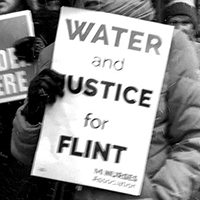
Flint's Drinking Water Disaster
View the page for this story
The powerful neurotoxin lead began leaching into the municipal water supply of Flint Michigan in April of 2014 when the city switched its water source and failed to add anti-corrosion agents. Virginia Tech water treatment and corrosion expert Marc Edwards tells host Steve Curwood about a string of mistakes and lies on the part of officials that led to the disaster that especially endangers child health. (12:20)

El Niño on a Warming Planet
View the page for this story
A powerful el Niño weather system born of heat in the Pacific is bringing heavy rains, ice and snow to parts of the US and typhoons to Asia. With record rainfall and flooding along the Mississippi River, Roy Buol, the mayor of Dubuque, Iowa describes what his city is doing to cope with the extreme weather. Host Steve Curwood and climate scientist Kevin Trenberth of the National Center for Atmospheric Research discuss the relationship between severe weather associated with El Niño and global warming and what we might expect as average world temperatures continue to rise. (12:05)

Beyond the Headlines
/ Peter DykstraView the page for this story
In this week’s trip beyond the headlines, Peter Dykstra talks to host Steve Curwood about a couple of heroes who shone a spotlight on the Flint water crisis, and a Nevada decision that could send rooftop solar costs right through the roof. Then they look back on a whiskey spill into a Scottish river that turned it into a (very weak) scotch and water. (04:25)
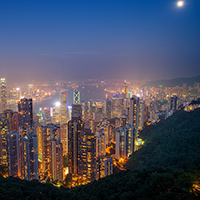
The End of Night
View the page for this story
Humans have always had a basic fear of the dark, but the advent of electric light in the late 19th century brought control over the night in the developed world. But with an explosion of light pollution blocking out the natural night sky in much of the world, author Paul Bogard tells Living on Earth’s Helen Palmer we might have gone too far and it might be harming our health. (08:25)
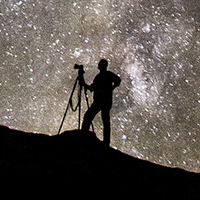
Conserving the Dark
/ Emmett FitzGeraldView the page for this story
The National Park Service protects the land, water, and wildlife in some of the most beautiful places in the United States. But Nate Ament, a park ranger based in Moab, Utah is working to protect another resource—darkness. In a world increasingly flooded with artificial night, a clear view of the night sky has become more and more rare. Reporter Emmett Fitzgerald takes a night walk to see the stars with Nate through Arches National Park. (10:00)
Show Credits and Funders
Show Transcript
HOST: Steve Curwood
GUESTS: Marc Edwards, Roy Buol, Kevin Trenberth, Paul Bogard
REPORTERS: Emmett FitzGerald, Peter Dykstra
[THEME]
CURWOOD: From Public Radio International, this is Living on Earth.
[THEME]
CURWOOD: I'm Steve Curwood. Water contaminated with lead flowed from taps in Flint Michigan for over a year until one Mom raised the alarm.
EDWARDS: The World Health Organization recommends that the most you ever drink in water is 10 parts per billion, and the water coming out of her tap was 13,500 parts per billion. This is more than 1,300 times higher, two-times hazardous waste levels.
CURWOOD: How it happened and how it could be fixed. Also, bright lights from cities can block out the stars but a few pockets of darkness survive.
AMENT: And a lot of visitors will say that it’s by far the most exciting and memorable part of their trip seeing the Milky Way over my head every night when I slept out, or seeing the stars in the dark sky that I’d never seen before.
CURWOOD: That and more this week, on Living on Earth. Stick around.
[NEWSBREAK MUSIC: Boards Of Canada “Zoetrope” from “In A Beautiful Place Out In The Country” (Warp Records 2000)]
ANNOUNCER: Support for Living on Earth comes from United Technologies – innovating to make the world a better, more sustainable, place to live.
Flint's Drinking Water Disaster
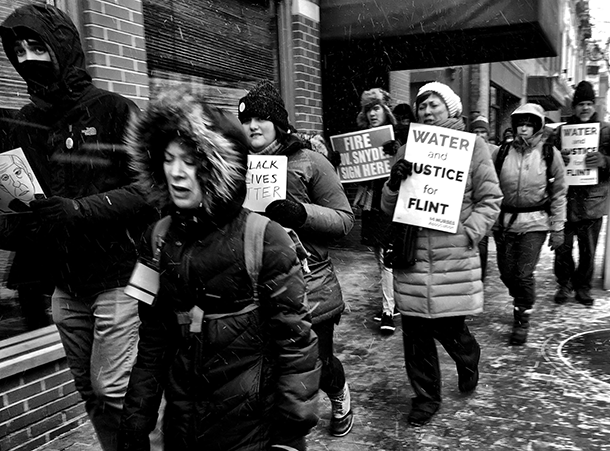
Protesters in Ann Arbor, Michigan called for the arrest of Governor Rick Snyder on Jan. 18th, 2016. (Photo: courtesy of Dennis Sparks)
CURWOOD: From the Jennifer and Ted Stanley studios at University of Massachusetts Boston and PRI, this is Living on Earth. I’m Steve Curwood. The drinking water disaster in Flint, Michigan began shortly after a change in its source as part of a cost-cutting measure in June 2014. Residents complained that their tap water suddenly smelled and looked bad, but local officials insisted it was safe. Still, LeeAnne Walters, a mother of four, wasn’t convinced, and she started to investigate further. She told Jack Olmstead of GMO Free Radio why she was so worried.
WALTERS: My child with a compromised immune system quit growing. We all developed rashes, we were losing our hair, and we knew something was wrong and kept getting told nothing was wrong. And by talking with other families, we figured out this was going on not just in my home and not just in the homes that had brown water, but all throughout the city and nobody was listening to us.
CURWOOD: LeeAnne Walters' investigations eventually led her to one of the foremost experts on the problem of lead in water, Marc Edwards, a civil and environmental engineer professor at Virginia Tech. He spoke with Living on Earth in 2009, when lead from aging pipes in Washington, DC, was also leaching into drinking water. Professor Edwards was called in to analyze Flint’s water and he’s on the line now from Virginia Tech. Welcome back.
EDWARDS: Thank you for having me.
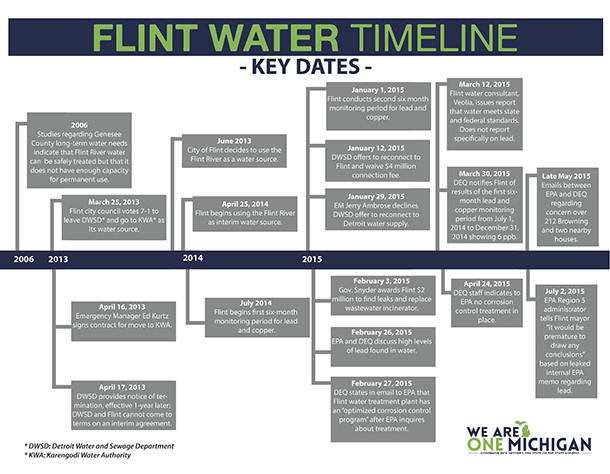
Michigan Governor Rick Snyder’s office released this Flint Water timeline to address questions on who knew what and when. According to the FlintWaterStudy, this timeline is missing some information, but overall is reasonably accurate. (Photo: Office of Michigan Governor Rick Snyder)
CURWOOD: So briefly what has happened in Flint with its water supply?
EDWARDS: What's happened is an entirely preventable man-made disaster that started out by not following federal law that requires addition of a corrosion control chemical to the water supply to protect the iron and lead pipes from corrosion. And this occurred during a switch from Detroit water that the city been using for a period of decades to Flint River water which runs through the town - it's a little bit of a saltier water source, a little more corrosive - and once that water was put into the system, a perfect storm of corrosion was unleashed. Red water, iron rust falling off of pipes was coming out of people’s taps at very very high levels. Lead was leaching into the water supply from the earliest days and pipes were breaking literally in the streets due to the high corrosion.
CURWOOD: Now, there's no way as a consumer to know that there is lead in your water. You might notice all that iron but you wouldn't be able to notice the lead, right?
EDWARDS: Well, unfortunately, there is a way, and it's the hard way. A mother found out her child was lead poisoned in Flint and figured out that not only was her water lead high, but that the state claims in writing to the EPA that they had been doing corrosion control was a lie. So you can't see lead, you can't taste it, but a mother could see that her child was not developing normally because she had twins and one of them was lagging, and she figured it out all on her own.
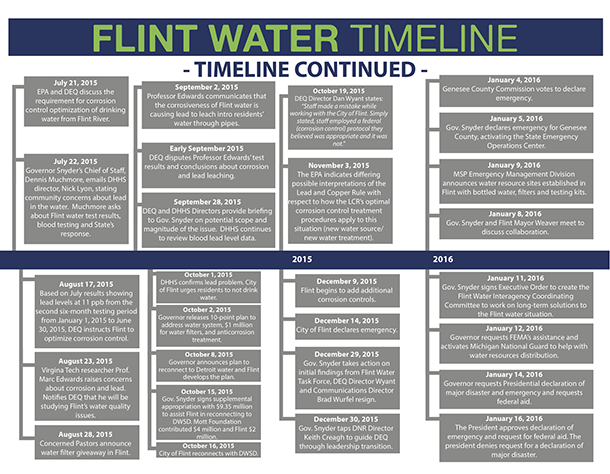
Timeline, continued. (Photo: Office of Michigan Governor Rick Snyder)
CURWOOD: How high where the lead levels in the drinking water there in Flint? How's that compare to what's legal?
EDWARDS: When we got involved with this hero Mom as I'll call her, LeeAnne Walters, we helped her sample her water supply and it was the worst lead in water I have seen in 25 years in this field.
CURWOOD: What were the numbers?
EDWARDS: The World Health Organization recommends that the most you ever drink in water is 10 parts per billion, and the water coming out of her tap was 13,500 parts per billion. This is more than 1,300 times higher than recommended levels, two times hazardous waste levels and that's not even the worst of it. She flushed her pipe for 20 minutes trying to clean it out and even after 20 minutes it was in the thousands of parts per billion.
CURWOOD: Mark, remind us of the health effects of lead, particularly in unborn and young children.
EDWARDS: Lead is the best-known neurotoxin. It adversely affects every system in human body. And for that reason, we pay people and pay them well to protect us from this hazard so that something like Flint would never happen, and unfortunately they failed miserably at doing their job.
CURWOOD: So this is a function of not putting this additive into the water that would keep this leaching out of the lead. What exactly was the reasoning of the city, of the government, to take this step? Why not add this?
EDWARDS: I think probably it started out innocently enough. I think they forgot to follow the law, but months and months into this...I mean, realize this is played out over about a 20 month time period, there was warning sign after warning sign that there were serious problems. Residents were getting red colored water coming out of their taps. They literally could not drink this water even though they were paying the highest water rates in the nation. General Motors, which has a plant in Flint, noticed that the water was eating up their car parts and had to stop buying Flint water and switch to a different water source, and the state was claiming all that time that there was nothing wrong at all. And even when they started detecting high lead in the water and they should've known better, rather than admit that they were breaking the law which not only they knew but the EPA regional office knew well since April of 2015, they didn't tell anybody. And so these outside people were figuring out these problems, while the very agencies that we paid to protect us from lead in water were lying to each other in writing. They were telling the public that the water was completely safe. If anyone said anything to the contrary, as we did when we started working with the residents, we were attacked. In fact, had outside people not gotten involved and exposed this, Flint kids would be drinking that water to this day.
MLive Video from Michigan media collaboration
CURWOOD: I understand there was a person that worked at the U.S. Environmental Protection Agency, the EPA, who had spoken out saying the water was unsafe. What happened to that person?
EDWARDS: Well, his name is Miguel del Toro, and he reached out to LeeAnne Walters and was the first one to really work with her and figure out that something was amiss in Flint. And he wrote a report that was very damning. It noted that Flint was not following federal corrosion control laws, that one child had already been poisoned and that the entire city was in imminent peril, and he leaked that to the press, and instead of taking it seriously, the Michigan State Department of Environmental Quality and even worse his boss, a political appointee, buried this memo, told him he could not talk to anyone about the Flint situation and actually went on a campaign to discredit him. What's happened here is a complete failure of our government. In this case, the EPA could've and should've been the heroes. Their employee did this amazing thing to protect the population, even put his job on the line to do so, and his boss snatched defeat from the jaws of victory, and covered this up and sat silently by for about eight, nine months while the city was just on the verge of civil unrest.

Michigan Governor Rick Snyder released nearly 300 pages of emails on Jan. 20th in connection with the crisis in Flint's contaminated water supply. (Photo: Michigan Municipal League, Flickr CC BY-ND 2.0)
CURWOOD: Marc, I know you've been studying city water supplies for much of your career. I imagine this is the worst case you have encountered.
EDWARDS: Actually it's not the worst case that we’ve seen. The worst case was actually in Washington, DC, from 2001 to 2004, and it was very similar. The agencies paid to protect us from lead in water, the United States Environmental Protection Agency, they were trying to do something good by changing disinfectants in the water supply and this new regulation triggered a massive lead contamination event, the worst in modern US history, and I think that the EPA was not used to being the bad guy, and emails that we uncovered as result of that investigation showed they knew about this contamination event and hid it from the public for three years until the Washington Post uncovered it and Washington DC went crazy. And unfortunately, rather than learning from that tragic event which we now know 10 years later, thousands of children were lead poisoned, there was a higher incidence of miscarriages and fetal death, which is an expected impact of lead in water exposure, and unfortunately the US Centers for Disease Control and EPA colluded to completely cover this problem up. They wrote a report at the height of the media outcry. It said not a single man, woman or child had blood lead elevated over the level of concern and that this was all much ado about nothing. Unfortunately that false statement stood for five years until I wrote a paper in 2009 and there was a congressional hearing that just reamed the CDC for their indefensible scientific reporting. Since that, we have dedicated ourselves to trying to prevent another DC from happening. Unfortunately we were unsuccessful. What you're seeing unfold in Flint is exactly the same thing that we saw before in Washington, DC, and no one was ever held accountable for covering up the problem and no one was held accountable for writing falsifying scientific reports and because no one was held accountable, what these agencies learned is nothing.
CURWOOD: Mark, what do you think it'll cost to clean the situation up?
EDWARDS: We estimate that extra damages done to the system are on the order of about $200 million, and that constitutes the damage to the city-owned pipe system and hasn't yet fully accounted for the damage to their home pipe systems. On top of that you have the human costs, the public health costs of childhood lead poisoning and increased help that these children will need in the years ahead. So the price tag is just astronomical. I mean, this is not only a public health disaster, it's one of the worst fiscal decisions I've ever seen.
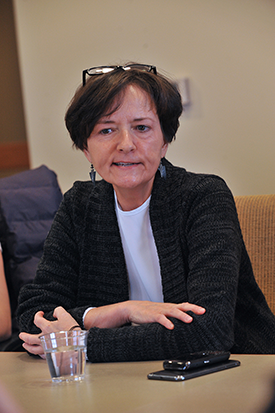
Susan Hedman, Administrator for EPA's Region 5 office, has come under scrutiny for the agency's alleged mismanagement of the Flint water crisis and has resigned. (Photo: Gerald R. Ford School of Public Policy, University of Michigan, Flickr CC BY-ND 2.0)
CURWOOD: So there are, what, more than 50,000 public drinking water systems around this country. How many of them have old lead pipes in them that could leach out lead that would be toxic if the wrong quality of water was passed through them?
EDWARDS: That's a very good question and no one has the answer to that. There are estimates that there're as many as 13 million lead pipes that connect homes to water mains across the United States, and while they are concentrated in certain cities and certain time frames when the house was built, no one really knows where these lead pipes are. So this is a major barrier to fixing this problem because over the years we've lost track of where these lead pipes are, and there's a good book written on this that called the decision to put these lead pipes in the ground in the first place one of the greatest environmental catastrophes in US history, and unfortunately we're still dealing with the legacy of that.
CURWOOD: That was Marc Edwards, an environmental engineering professor at Virginia Tech. We contacted the EPA for comment. They admit they failed to act quickly enough but also fault state and local officials. Meanwhile, President Obama has declared a state of emergency and Michigan Governor Rick Snyder has publicly apologized and promised to fix the problem.
Related links:
- About Marc Edwards and the Virginia Tech Research Team
- Coverage of Flint lead crisis by date
- State of Emergency Declared Over Man-Made Water Disaster in Michigan City
- Video: Water Sampling Kits for Lead
- The EPA’s Safe Drinking Water Act
- The Lead and Copper Rule for drinking water
- More on lead poisoning
- EPA’s region 5 administrator resigns
- Leanne Walter’s organization: Water You Fighting For?
[MUSIC: Harry Belafonte, Sylive, Sing Your Song, Sony Music]
CURWOOD: Just ahead...how El Niño and its associated record-breaking floods, storms and droughts relate to global warming. Stay tuned to Living on Earth.
[CUTAWAY MUSIC: Performed by Albin Freda/Herman Cross, “Desperado,” Composed by The Eagles, Asylum/Atlantic Records]
El Niño on a Warming Planet
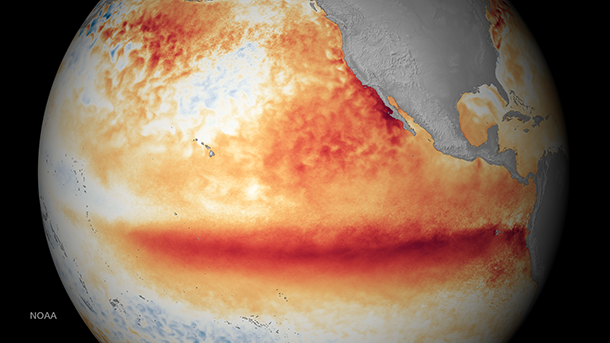
El Niño weather pattern in the Pacific (Photo: NOAA, CC BY-2.0)
CURWOOD: It’s Living on Earth, I’m Steve Curwood. The heavy rains associated with El Niño this winter brought record floods to the Mississippi River basin. Roy Buol is the Mayor of Dubuque, Iowa, along the Mississippi. His city didn’t experience the devastation of some other cities nearby, but all this rain has him concerned.
BUOL: It is very very unusual weather that we have been experiencing, you know the amount of rain, the intensity, the amount of flooding that’s occurring up and down the river. This obviously is one of the bigger events that collectively we’ve seen.
CURWOOD: Mayor Buol says that many of the residents in his town are connecting the dots between these storms and global warming, and the city is taking steps to become more resilient in the face of increasingly wild weather.
BUOL: As flooding becomes more severe and unpredictable we realized that we needed to protect our residents and our infrastructure by making some aggressive changes in our city. Now the city of Dubuque is working with the Army Corps of Engineers to assess the strength of our floodwall or levy, which has protected the city from the Mississippi since 1965. We are now reviewing overtopping and failure scenarios and exploring how we can mitigate flooding if the floodwall were to fail due to climate change results. And the historic flooding levels that the Mississippi River potentially could have in the city Dubuque.
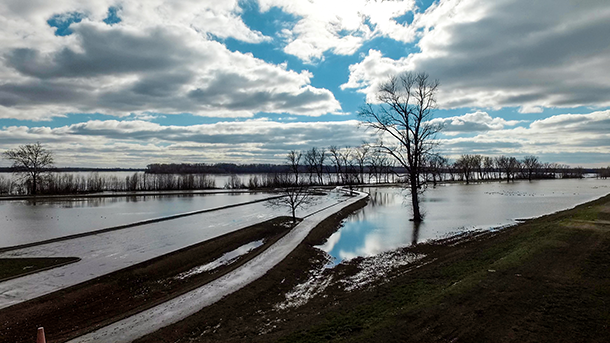
Mississippi flooding outside of St. Louis (Photo: N, Flickr CC BY-NC-ND 2.0)
CURWOOD: Dubuque is part of the Mississippi River Cities and Towns Initiative, which seeks to increase collaboration among river communities on ways to adapt to climate change. Mayor Buol joined mayors at the Paris climate summit in December to talk with leaders from other river basins around the world. They reached an agreement to work together.
BUOL: And we actually got 15 basins to sign on to that agreement to work together to create resiliency and some best practices, knowing full well that the Mississippi River is the food basket of the world, and that population increases over the next 20 years when we hit 9.5 billion people, those people are going to have to be fed. So we’re trying to work with them to create some global cooperation around water and food security.
CURWOOD: That’s Dubuque Mayor Roy Buol.
Whether it’s heavy ice and snow or torrential rains, the extreme weather events around the world linked to El Niño don’t always come out of the blue. Scientists have been warning of the possibility of a strong El Niño since 2014, and such warnings, if heeded, can help communities cope. We often turn to distinguished scientist Kevin Trenberth of National Center for Atmospheric Research to talk about El Niño’s impacts around the world. Kevin, welcome back to Living on Earth.
TRENBERTH: Thanks for having me.
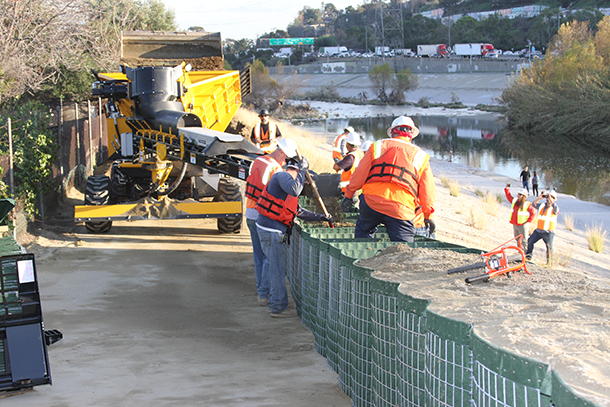
The Army Corps of Engineers installs a barrier along the Los Angeles River to prepare for this winter’s El Niño. (Photo: US Army Corps of Engineers Public Affairs, CC BY-ND 2.0)
CURWOOD: First, just remind us of the El Niño phenomenon. People use this phrase all the time but what exactly is it?
TRENBERTH: It really refers to a warming of the central and eastern Pacific. Prior to El Niño there is a buildup of heat in the ocean. The ocean heat content and higher sea levels in the western tropical Pacific and then during El Niño, that heat spreads across the Pacific, it comes back into the atmosphere mainly in the form of, well, cooling the ocean but evaporative cooling of the ocean and then moistening of the atmosphere and then that moisture gets caught up in weather systems and invigorates weather systems around the world and especially in the Pacific and that gives back the heat to the atmosphere that went into evaporating the atmosphere in the first place. And so there is a mini global warming in the latter stages of an El Niño event and so this El Niño has also contributed to 2015 being the warmest year on record, actually by far.
CURWOOD: So, what are the major weather effects from this strong El Niño that we're in the middle of right now?
TRENBERTH: Starting last summer in particular and in March of 2015, there was a major hurricane or cyclone that went through Vanuatu in the southern hemisphere and that was only enabled by El Niño conditions. It would not have happened without El Niño. And then in the summertime in the northern Hemisphere, we saw a record number of both hurricanes and typhoons, and a tremendous amount of damage in various places - the Philippines, Japan, China, Taiwan, Vietnam and so on. The largest number of category four and five storms on record by a substantial amount. And it got a considerable boost from the El Niño phenomenon. And then the patterns of weather began to change and so there's been a major drought in Indonesia with tremendous number of wildfires. And there are clear connections into North America, into the United States and so the sort of thing that we saw recently with major flooding especially focused on Missouri and very wet conditions in November and December as a whole. So, November and December as a whole in the state of Missouri had three times their normal rainfall for those two months and the previous record was about twice the normal amount.
CURWOOD: It's just so overwhelming, that list of the phenomenon associated with El Niño.

El Niño has led to increased snow in the mountains of Southern California, but much more is needed to get out of the region’s drought. (Photo: Russ Allison Roar, Flickr CC BY-NC-ND 2.0)
TRENBERTH: Well, one of the other things that we see, of course, is that there are storms that start to barrel into California and so it had some substantial rains in Southern California and at the moment the focus is a bit more on Northern California and even Washington and Oregon and there has been flooding in those areas, and it's not as if they are not accustomed to having heavy rains, but the rains that are coming off of the Pacific this year are quite prodigious.
CURWOOD: Now, in the West where there's been such a horrible drought, to what extent is this El Niño now bring relief, do you think?
TRENBERTH: Well, it should bring substantial relief and, of course, it will bring relief to agriculture and the phenomena that are important for the upper part of the soil layers and so on. The real issue that people talk about is the storage of water in reservoirs and rivers and lakes and one of the things that has happened in recent times is the mining of groundwater. And so in some parts in central California the ground has actually sunk as a result of the pulling out of the groundwater and unfortunately a lot of that seems to be irreversible. So you can't put the water back very easily, and unfortunately California has developed a system where they try to protect against floods and so a lot of the water that occurred in Southern California has gone into the Los Angeles River and it has run out to sea, instead of going back into the ground where it could be perhaps mined again in the future. And so this relates to how we work with water in the United States. There is one group that is designed to prevent floods, but there's another group who deals with droughts, and these two need to get together so that they save the water from the time when they've got too much for the times when you don't have enough and that's the thing which is really missing at the moment.
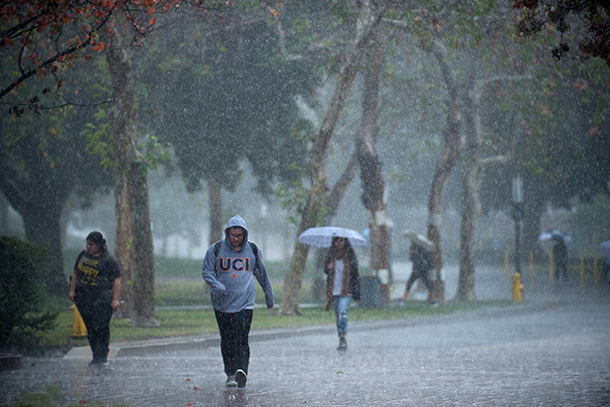
Rain on the campus of UC Irvine (Photo: UC Irvine, CC BY-NC-ND 2.0)
CURWOOD: That's right. You were saying back in April 2014, this is a year and a half ago, a little longer, that we would likely see a fairly intense El Niño phenomena with all this rain going to California, so if in fact there were mechanisms to plan for a lot of rain and capture it, there would be a fair amount of time. You guys are pretty good at predicting this.
TRENBERTH: Well this is one of the things about the science, is that we agree there is much more notice about the likelihood of El Niño occurring and therefore various kinds of activities, not only in California but in other places around the world, are able to change their activities or plan for this or plan for the risk of wildfire in Australia, for instance, in a number of places around the world they actually change the crops they grow, the seeds they plant, the fertilizer strategy, the irrigation strategy, managing hydroelectric power in places that water comes and goes and these kind of events, all of these kinds of things, is the sort of thing that can take advantage of good warnings that these kind of events are under way.
CURWOOD: I really don't want to ask you this question but I have to. When we look at climate distraction, look at global warming, we see that it's on the increase. So if this is the way things are now with the El Niño phenomena, what could we be looking at the planet gets even warmer?
TRENBERTH: In some sense what we're seeing around the world right now is a advanced view of the sort of things that we'll see more off in the future, all of the weather systems being somewhat more vigorous than they have been in the past, the risk of both droughts in some regions and flooding in other regions, and of course, this is very difficult to manage for a farmer - it's much tougher on ecosystems and forests in general. And so these are some of the challenges, but taking lessons from these relatively short-term surges where the mini global warming from El Niño goes along with the global warming from increases in greenhouse gases. Those two things going together is the sort of thing that creates new records and some things begin to break.
CURWOOD: Some things begin to break. What you have in mind?
TRENBERTH: So, scientists say, “well things have gone non-linear”, and so this is where the case in Missouri is a good example. Previously what is the average rainfall there in November and December somewhere around five inches of rain and the previous highest was somewhere around 10 inches of rain, and in this past November, December we're at 15 inches of rain. I mean, there's no reason based on the previous record to expect that, but suddenly we're jumping to a whole new arena and it has consequences and is having big consequences now as it slowly unfolds as the Mississippi River rolls this water downstream.
CURWOOD: How much longer does this El Niño event last do you think?
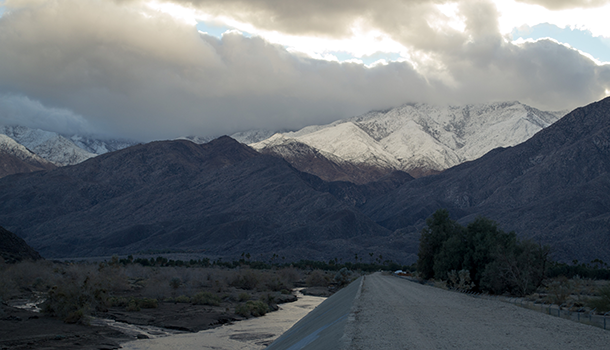
Snow in the San Jacinto mountains in Southern California (Photo: Don Barrett, Flickr CC BY-NC-ND 2.0)
TRENBERTH: Well it looks like this El Niño may have peaked in November in terms of the magnitude of the unusual sea surface temperatures out in the tropical Pacific, and so already it's beginning to fade just a little bit. It's certainly going to be with us through March, but by about April it's expected that this will be fading quite substantially and it'll be basically gone by about June. And so this is the transition, it's the normal time of length of a normal El Niño to last, so exactly how this plays out in the next few months given that it's already beginning to fade a little bit will be interesting to see, but often some of the biggest effects do occur around February across North America.
CURWOOD: So, let's see. Last time we saw ice storms, we saw crazy water in Florida...so I guess we just have to hang on until this is over, huh?
TRENBERTH: This is one of the risks that because conditions are a bit warmer, they are a bit warmer because of the El Niño, that you have vigorous storms coming across the country, but the ground can still be very cold so the risk of an ice storm, a freezing rain storm is a very real one. And this is what happened in 1998 which devastated upper parts of New York state and parts of Canada, for instance, and that is certainly one of the possibilities on the cards.
CURWOOD: Kevin Trenberth is a distinguished senior scientist at the National Center for Atmospheric Research in Boulder, Colorado. Kevin, thank you so much for taking the time today.
TRENBERTH: You’re most welcome.
Related links:
- Kevin Trenberth’s interview predicting a strong El Niño this winter
- The impact of El Niño on the California drought
- Photos of devastating floods along the Mississippi
- Global coral bleaching is exacerbated by El Niño
[MUSIC:Eddie Pennington, Over the Rainbow, Walks the Strings ..and even Sings, Smithsonian Folways]
Beyond the Headlines

Rooftop solar in the state of Nevada just got a lot more expensive, following a vote by the state’s Public Utilities Commission. (Photo: Duncan Rawlinson, Flickr CC BY-NC 2.0)
CURWOOD: Time to catch up again with Peter Dykstra and go beyond the headlines. Peter’s with Environmental Health News – EHN.org – and the DailyClimate.org and joins us on the line from Conyers, Georgia. So, how are you, Peter?
DYKSTRA: I’m all right, Steve, how about you? You know, that drinking water crisis you were talking about earlier deserves a little bit more mention. The situation in Flint, Michigan is both a human tragedy and a political scandal. Governor Snyder’s taking the heat. There are calls for his resignation, the state agency is being pummeled for moving too slowly and the Federal EPA said they didn’t do anything because they thought the state was going to do something.
CURWOOD: Ok, so that’s blaming, but you know the blame game only gets you so far.
DYKSTRA: Well, yeah, you’re right. That’s why I want to focus on a couple of heroes in this horrible situation. One of them is a journalist named Curt Guyette, he’s a long-time Michigan investigative reporter, he took a job last year with an advocacy group the Michigan ACLU and started going door-to-door with volunteers to collect water samples for testing. And while Curt Guyette and his volunteers were doing that there was a pediatrician in Flint named Mona Hanna-Attisha – she started testing blood-lead levels in Flint’s kids. The two of them put their data together and it pointed to a huge problem and an eventual scandal.
CURWOOD: So give credit where credit is due, but I sense that you think that maybe there’s still some blame to go around.
DYKSTRA: Yeah, let me get one little bit of the blame game here. When this deal came together to bring cheaper, local water to the residents of Flint, Michigan, The Flint Journal, the local newspaper, wrote an editorial saying it was a wonderful deal. They said it was carefully vetted. They said, "The change will be virtually unnoticeable," and they also said this is a ‘new direction for Flint.’
Video about Pediatrician Mona Hanna-Attisha, courtesy of WJRT ABC12, Flint, Michigan.
CURWOOD: It may be a new direction but … ouch! Ok, what else are we going to talk about today?
DYKSTRA: I want to talk about a move in the state of Nevada that may kneecap the booming rooftop solar business that’s been going on in that state and across the country.
CURWOOD: How so?
DYKSTRA: The state Public Utility Commission voted to triple the amount rooftop solar owner would have to pay the state’s biggest utility, NV Energy, in order to have a way to generate their homegrown power. And at the same time they would cut the fees that the utility pays back to rooftop solar owners when those solar owners can move electricity to the bigger grid.
CURWOOD: You’re right. That would knock rooftop solar right out of the business. So what was the reason of the public utility’s commission for this?
DYKSTRA: The utility makes less money on homegrown electricity. About 63 percent of the electricity in the state of Nevada comes from natural gas, the governor of the state of Nevada, Brian Sandoval, who’s a Republican, warned the utility commission that there are a lot of new jobs coming on line due to solar and big solar companies like SolarCity have threatened to either move out or sue.
CURWOOD: So we’ll keep an eye on that one. Let’s turn a leaf now on the history calendar. Peter, what do you see?
DYKSTRA: I got something for you. It’s a little bit lighter, maybe even a little … tipsy. It was two years ago this week that a fine was levied for one of the world’s most disastrous whisky spills in a river. Took place in the Ayr River in Scotland. A tanker truck full of whisky arrived at a bonded warehouse. It was combination of errors. There were human errors, there were computer errors, they think it was about 5,000 liters of 130 proof whisky and since this was Scotland you can probably figure out what type of whisky it was. The warehouse was eventually fined 12,000 pounds, which is about $20,000 dollars.
CURWOOD: For scotching the river?
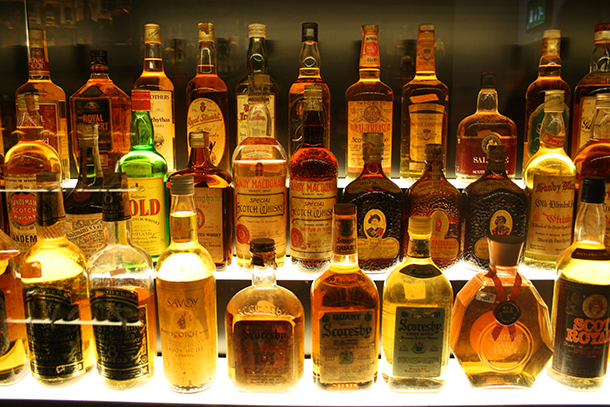
5,000 litres of scotch whisky spilled into the Ayr River two years ago. (Photo: Milos Kravcik, Flickr CC BY-NC-ND 2.0)
DYKSTRA: For scotching the river. And that $12,000 fine assumed some environmental damage but nobody ever really took the time to figure out if there was any environmental damage so I started looking at some of the flow data from the Ayr River that’s available online.
CURWOOD: Mmhmm.
DYKSTRA: The amount of water that goes through that river – about 4.7 million gallons of water an hour, 5,000 liters of scotch whisky in there would make the weakest $20,000 scotch and water ever.
CURWOOD: Reminds me of what you can get served at certain establishments Peter. But somebody must be upset that all that whisky is sleeping with fishes.
DYKSTRA: Yeah, it’s a terrible terrible waste.
CURWOOD: Peter Dykstra is with environmental health news that’s EHN.org, the DailyClimate.org. and there’s more on these stories on our website LOE.org. Peter thanks so much for taking the time with us today. Talk to you next time.
DYKSTRA: Alright, Steve, thanks a lot we’ll talk to you soon.
Related links:
- How an investigative journalist helped prove a city was being poisoned with its own water
- Flint doctor makes state see light about lead in water
- The Flint Journal Editorial: Switch to Flint River water represents new era in Flint
- Nevada decision guts the state’s thriving solar industry
- Regulators deal a blow to rooftop solar industry
- 7,140 bottles of whisky spilled into River Ayr
- Scottish EPA water level data
[MUSIC: Ralph McDonald/W Salter, Calypso Breakdown, Saturday Night Fever, Original Soundtrack, Polydor]
CURWOOD: Coming up...in search of the dark and the distant stars it reveals. That's just ahead on Living on Earth. Stay tuned.
ANNOUNCER: Funding for Living on Earth comes from United Technologies, a provider to the aerospace and building systems industries worldwide. UTC Building & Industrial Systems, provides building technologies and supplies container refrigeration systems that transport and preserve food and medicine with brands such as Otis, Carrier, Chubb, Edwards and Kidde. This is PRI, Public Radio International.
[CUTAWAY MUSIC: The Full Moon Guitars, Eagles, The Long Run, Elap Music Ltd]
The End of Night
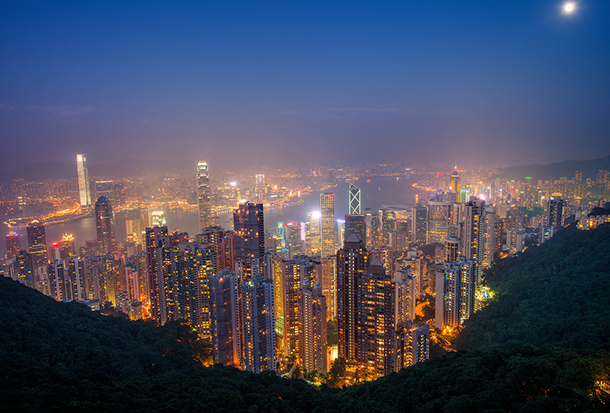
Light pollution in major cities prevent many people from experiences natural darkness and a clear night sky (Photo: Tom Bricker, Creative Commons 2.0)
CURWOOD: It's Living on Earth, I'm Steve Curwood. If you’re a stargazer and are able to see the stars where you live, the dawn skies offer a spectacular treat at the moment. Five planets are lined up diagonally for the first time in over a decade – Mercury, Venus, Mars, Saturn and Jupiter. Of course, more than half of the world’s population now lives in cities, and the glaring lights increasingly make the sky too bright to see the stars. That’s a concern for Paul Bogard, who wrote the book “End of Night” which examines the increasing use of light for public safety, which results in light pollution blanketing our world and blotting out the heavens. He spoke with Living on Earth’s Helen Palmer.
PALMER: Now one of the reasons that I think people have embraced light is this basically fear of the dark. Do you think that's really what's at the base of the growth in light?
BOGARD: Well, you know it's a complex problem, a complex issue but I do think that we have a basic fear of the dark. I sometimes laugh because I admit in the book that I'm afraid of the dark and people think, you're the guy who wrote the book on the value of darkness, how can you be afraid of the dark? But I think it's a perfectly natural thing to be afraid of the dark. I think what's not natural is then to compensate for that fear by trying to light up our nights as bright as our days and to think that we can somehow do away with darkness by turning up the lights ever brighter.
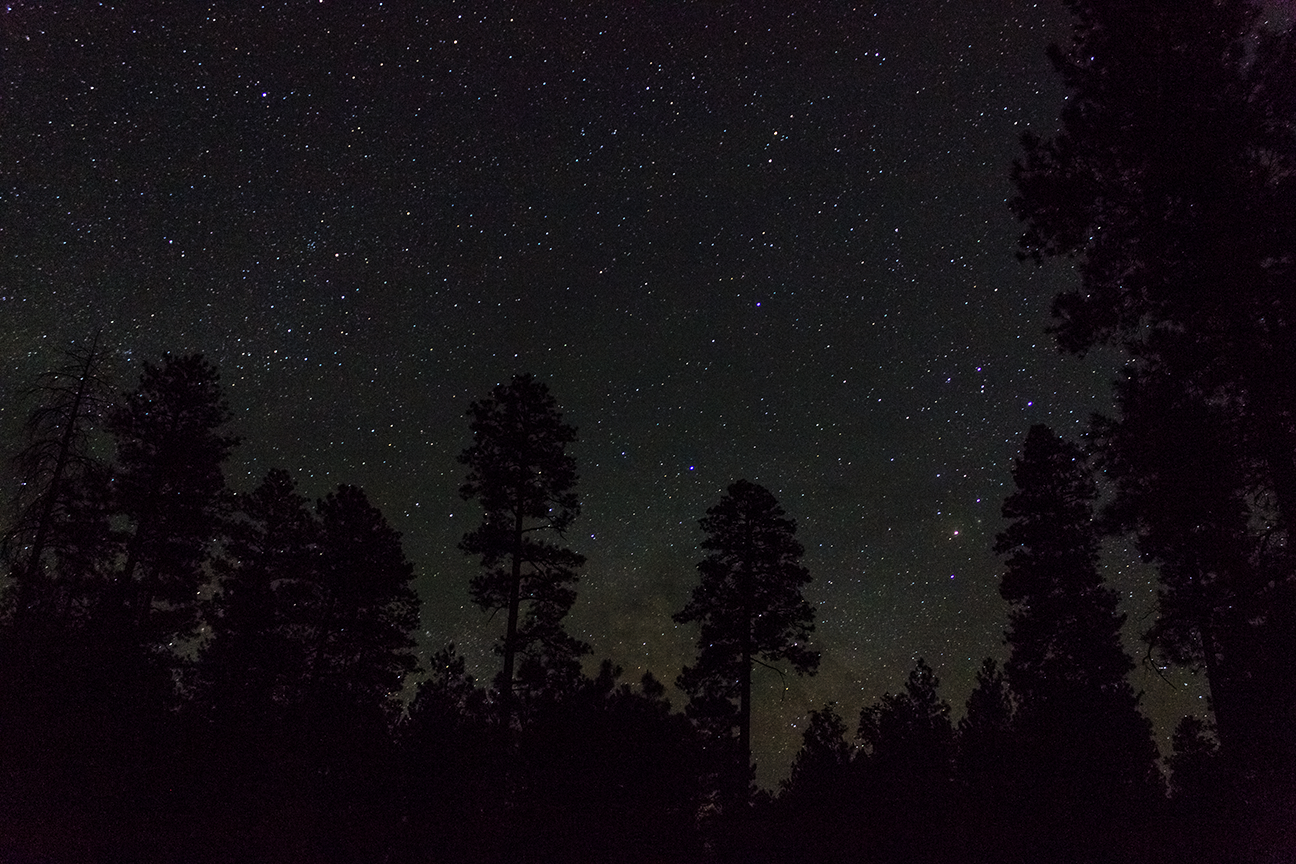
Paul Bogard met many dark sky enthusiasts who seek out the earth’s darkest places (Photo: Jay Raz, Creative Commons 2.0)
PALMER: But I think there is this feeling that with the light will come security. You have this feeling of the murderer or thief sort of lurking in the darkness. And so, obviously, we turn on the lights to become more safe. Has it made us in that way more safe? Does more light make us more safe?
BOGARD: Yeah, sure, I think that's really at the heart of it, and when you ask people, do we need all this light, people say often times, well, yeah we need it for safety and security, but the truth is that while some light can help us be more safe and secure and no one's suggesting that we just turn off all the lights, what people are suggesting is that we don't need all this light for safety and security and that in fact when you have ever more light you often create more problems than solutions. Oftentimes when you have lights they’re too bright, they cast shadows where the bad guys can hide. There's so much light in our nights that are glaring lights that make it hard for us to see, and then also, too much light tends to create the illusion of safety. We think we can be reckless purely because it's light out and that's obviously not the case.
PALMER: So it basically destroys our night vision as well.
BOGARD: Yeah it really does. One of the most startling estimates that I found what I was doing research for the book is that some 40 percent of Americans and Western Europeans never experience or rarely experience night vision. We're in the lights so much that our eyes never switch to night vision.
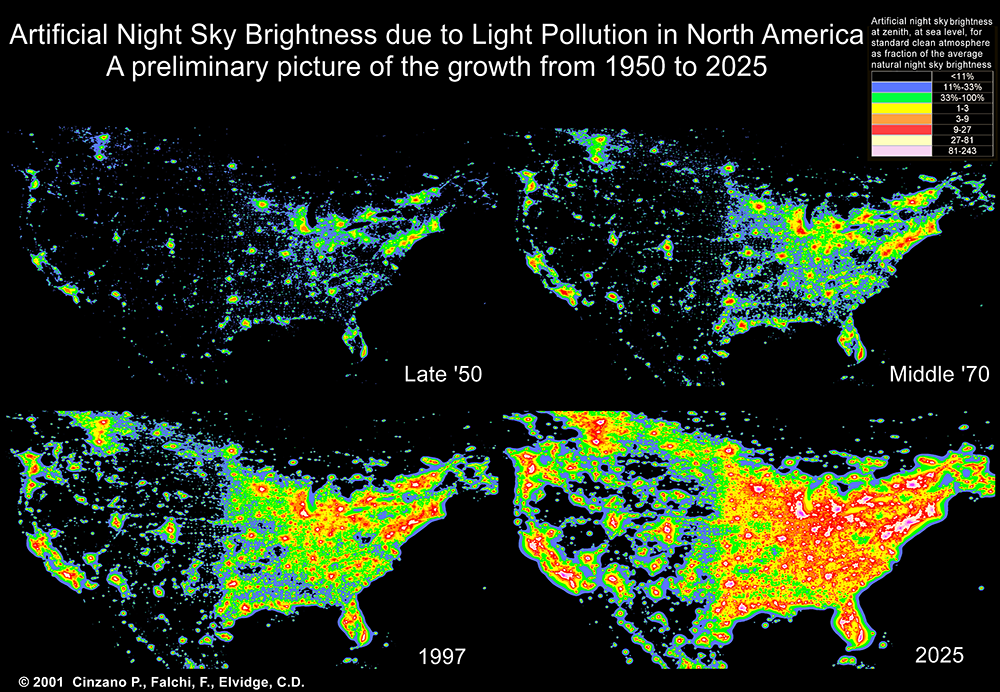
Growth in light pollution in the last 75 years (Photo: P. Cinzano, F. Falchi [University of Padova], C.D. Elvidge [NOAA National Geophysical Data Center, Boulder]. Copyright Royal Astonomical Society. Reproduced from the Monthly Notices of the Royal Astromical Society by permission of Blackwell Science)
PALMER: You told that very sad story of somebody saying, what are all those white dots up in the sky?
BOGARD: Exactly and you know if you live in a major urban area, major city, you're not seeing anything close to the night sky that we ought to be able to see, and I had several nights when I was traveling for the book where, say, I was standing on a bridge in London and I looked up and I could count about 20 stars and that's just, that's nothing when it comes to the night sky.
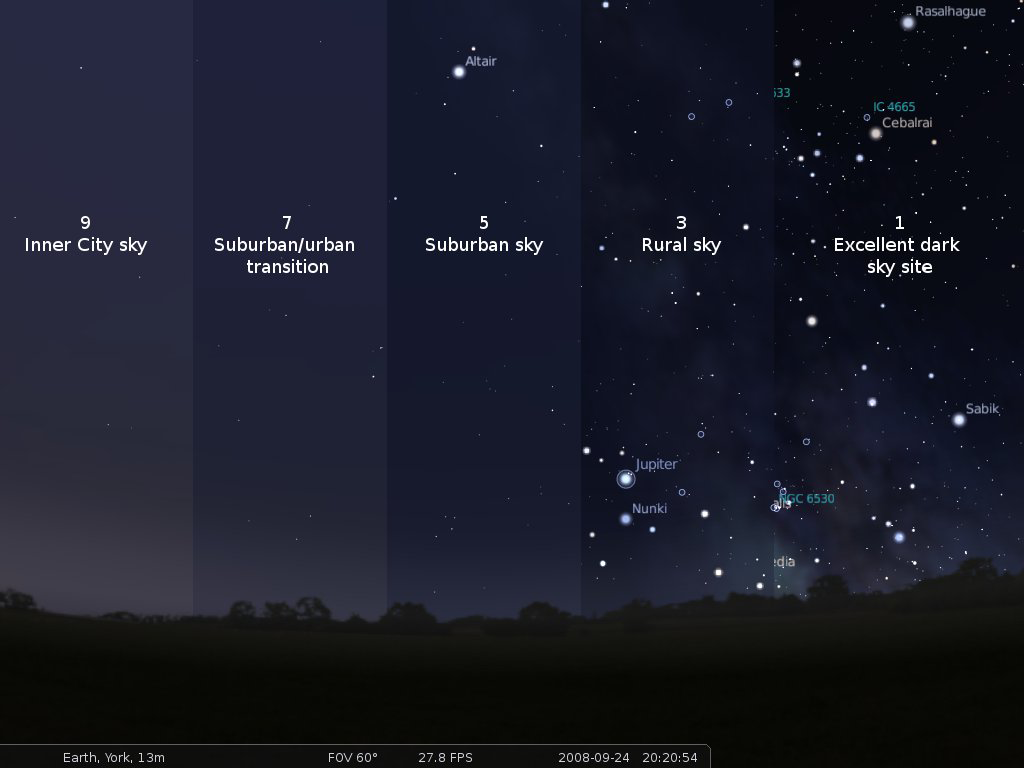
The Bortle Scale (Photo: The International Dark Sky Association)
PALMER: Well it's not only the inability to see the stars that the problem. You actually point out that this excess light is actually making us sick.
BOGARD: We're learning more and more. More and more research is in fact showing us that light at night in fact is impacting our physical health and in three primary ways. It’s interrupting our sleep and contributing to sleep disorders, which are tied to every major disease that we're dealing with now. It's confusing our circadian rhythms, those internal rhythms that orchestrate our body's health and then perhaps most troubling it's impeding the production of the hormone melatonin. Melatonin is only produced in the dark and what scientists are finding is that a lack of melatonin in our bloodstream is linked to an increased risk for breast and prostate cancer. So nobody is saying that yeah, that light at night gives you cancer, but what everyone I talk to did say was we've evolved in bright days and dark nights just like all life on Earth and we need both for optimal health. To think that we can simply flood our nights with artificial light and have it not have an effect on our health is probably foolish.
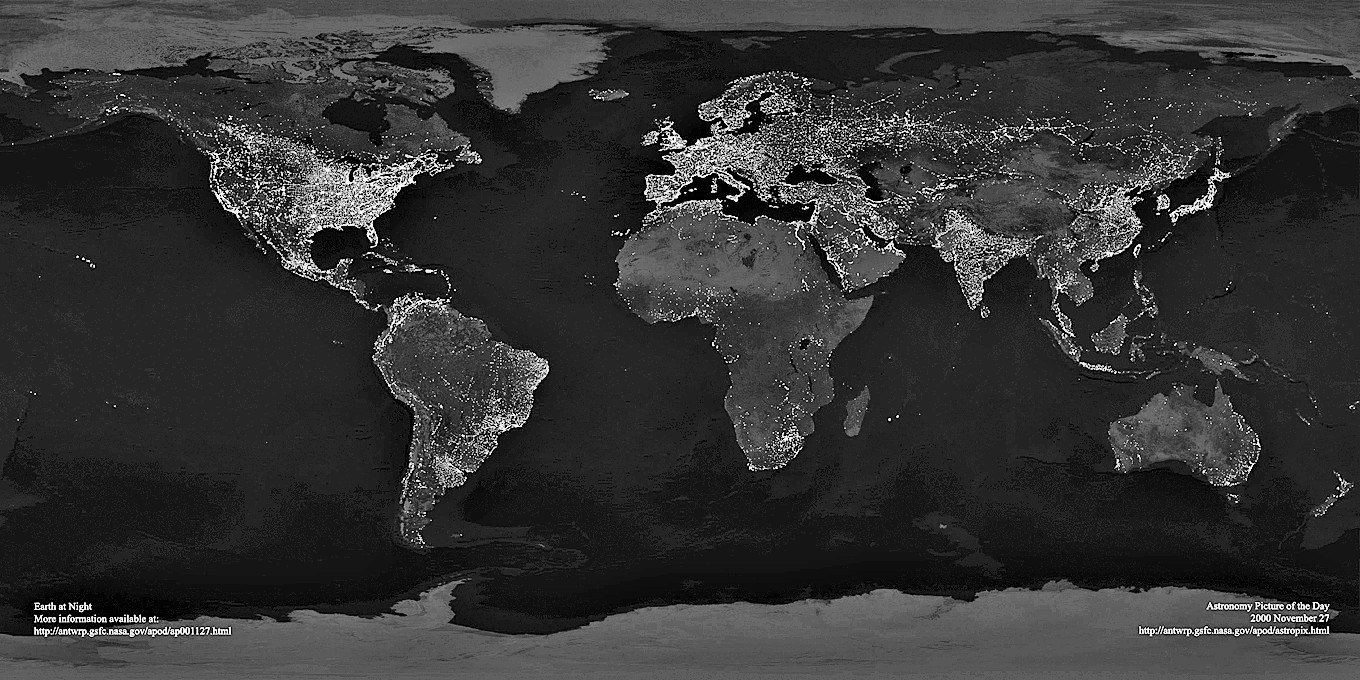
The earth at night (Photo: C. Mayhew & R. Simmon (NASA/GSFC), NOAA/NGDC, DMSP Digital Archive)
PALMER: One thing that I know night workers complain about is that they all put on weight. It seems to somehow in fact really upset the circadian rhythms in terms of digestion as well.
BOGARD: Yeah, it really does and I think you know the folks that are bearing the brunt of all the light probably most directly right now are those people who are working the night shift or rotating shifts and that happens to be more and more of us. And too often it's the poorer folks who need to work at night, but I talked to a number of folks who work the night shift who have put on weight and just say it's really really difficult to live this way. You feel exhausted all the time, you feel tired all the time and they can sense that it isn't right but they have to do it.
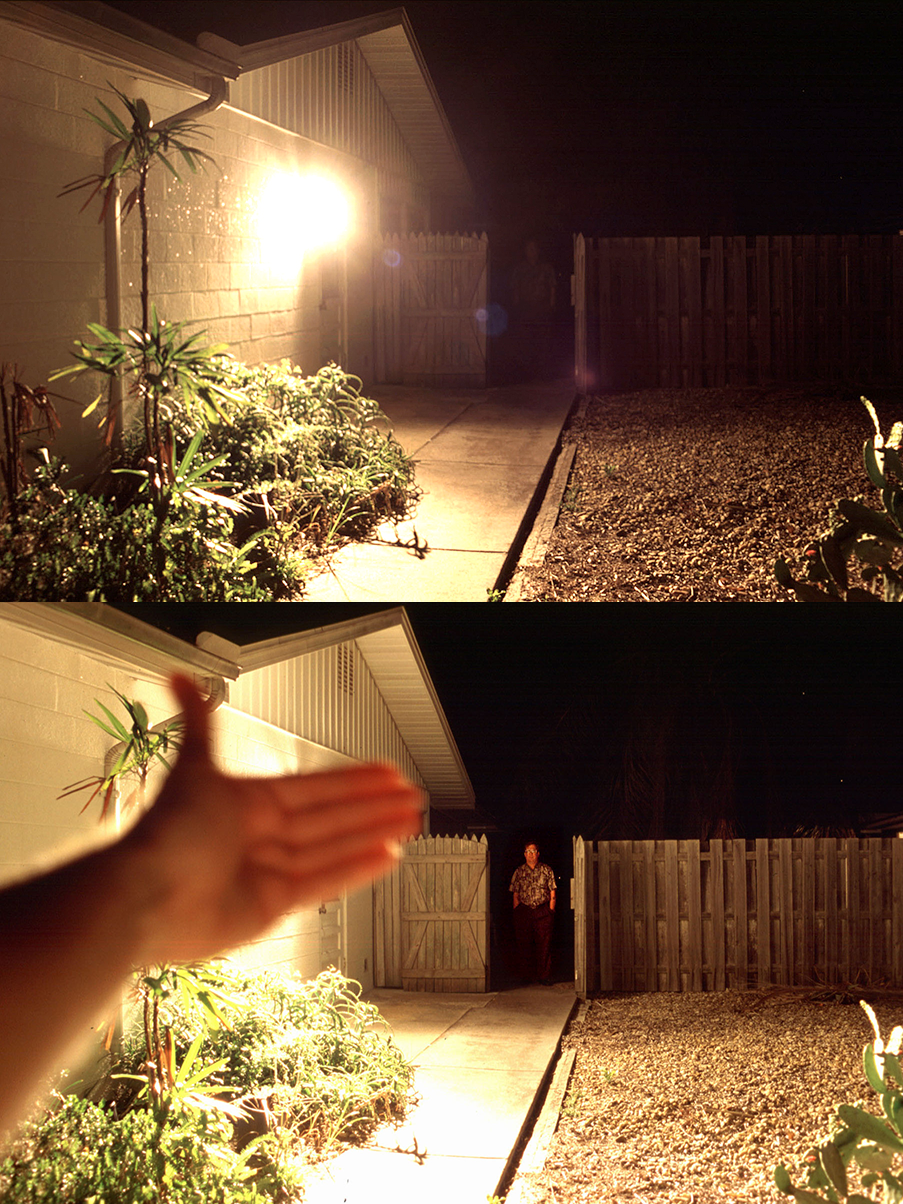
Excessive glare from artificial lights can actually make it more difficult to see people lurking in the night (Photo: George Fleenor)
PALMER: Well even if we actually sleep in a theoretical dark room, there are all these sort of LED lights, the little lights on the alarm clocks by our bed. There are the lights on our watches, the lights on our phones. It's amazing if you just look around the bedroom—theoretically, the dark bedroom—what is still on.
BOGARD: It's true. We have a lot of little lights. And I think a lot of folks aren't even aware of how important it is to be sleeping in the dark, to pull those shades completely shut and to turn off the lights in the hall room and to, if you get up to use the bathroom in the middle of the night, to not turn that bright light on. One thing that researchers are seeing a lot of is that people are doing a lot of reading on the computer, on the tablet, their phone, what have you, right up to the time they turn off the light and go to sleep at night, and this keeps the production of melatonin from starting when it normally should. What scientists are finding is that it's the blue lights in the screen that's having the most negative effect on our physical health and a lot of the new LEDs that we're seeing in our streetlights and a lot of our gadgets are really heavy with this blue-rich white light that we really shouldn't be seeing in the night.
PALMER: One of the things you're doing in your book is going around searching out these advocates for the dark skies across the world. Actually there seem to be many of them. What did they advise or could we basically do to reverse this trend of ever brighter, ever brighter, ever more destructive?
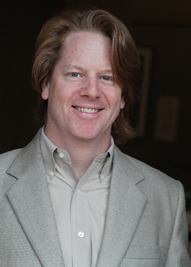
Paul Bogard (Photo: James Madison University)
BOGARD: Well you know I'm optimistic about it. I think there's a lot that we can do and it starts with the way that we use lights and I like to say that light at night is not the problem, it's how we use it. So that is true in our homes where we can have light that is shining only downward, we can turn off our lights when we go to bed, that continues into our communities where we can have a lighting ordinance in our communities that will describe the kind of night that we want to have in the places that we live. Most of us don't want to live in places with glaring super bright ugly lights. We prefer to have lighting that is subtle and nuanced and maybe even beautiful even as it provides us with the safety and security that we know we want. So, from the individual all the way up to the community and even on the statewide level there are things we can do right now to begin to control this.
PALMER: Things like downward pointing street lights and stuff like that?
BOGARD: Absolutely. One of the biggest problems that we have with our lighting, one of the, I guess, biggest basic problems is that we have light shooting in all directions right now, and we have light that is being sent straight into the sky and we have light that's being shined into our eyes as drive down the street and we have too much light that's just shining from one neighbor or one streetlight into our houses and none of that light is doing any good. In fact, it's just all wasted light. So simply by directing our light downward just to where we need it we can have a huge positive impact.
CURWOOD: Paul Bogard wrote the book “End Of Night”. He teaches English at James Madison University in Virginia and spoke with Living on Earth’s Helen Palmer.
Related links:
- Paul Bogard’s website
- Light Pollution Map
- Light Pollution And Astronomy: The Bortle Dark-Sky Scale
Conserving the Dark
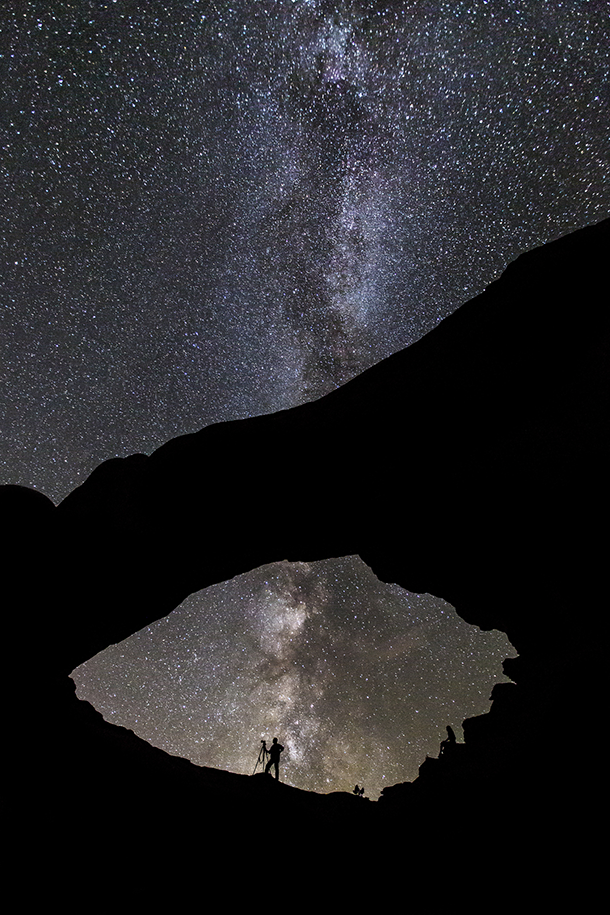
The view of the cosmos through the South Window at Arches National Park (Photo: Jacob W Frank)
CURWOOD: Some conservationists are also now counting dark skies among other threatened resources and celebrating them where they still persist. Canyonlands National Park in Utah was recently named an International Dark Skies Park, and the Park Service is working to get a similar designation for nearby Arches National Park. Living on Earth’s Emmett FitzGerald went to see for himself.
[FOOTSTEPS]
FITZGERALD: Tonight isn’t really the best night to see the stars. The moon is two thirds full above Arches National Park in Eastern Utah. But that hasn’t deterred my guide.
AMENT: My name is Nate Ament. I'm the Colorado Plateau Dark Skies Coordinator for the National Park Service. We’re headed towards the North Window, we’re going to do some stargazing and look at the landscape under the moonlight here.
FITZGERALD: This park is named after its signature red rock arches, or windows, so massive you could drive a fire truck under them. Nate’s been out here countless nights, but he says it still feels like the surface of Mars.
AMENT: I came out here for the first time when I was just a little kid, and this was just magic land for me. I mean it still is, but I just didn’t even know that landforms like this existed. It just boggled my mind. It’s totally otherworldly.
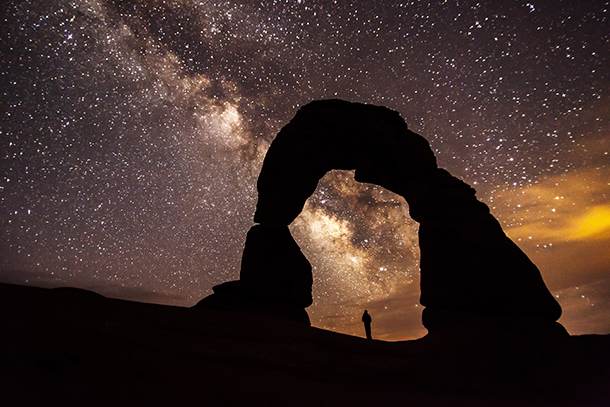
The night sky above Arches National Park (Photo: Jacob W Frank)
FITZGERALD: Nate points out the spot where the writer Edward Abbey parked his trailer when he worked for the National Park Service here in 1956 and 57. Abbey’s field notes from that stint formed the basis his iconic book Desert Solitaire. Abbey wrote of his dark nights in Arches:
Leaving the flashlight in my pocket where it belongs, I remain a part of the environment I walk through and my vision, though limited, has no sharp or definite boundary. The night flows back, the mighty stillness embraces and includes me; I can see the stars again and the world of starlight.
[FOOTSTEPS]
We pass the North Window, a giant eye-shaped hole in the rock wall and head south. Nate’s wearing a headlamp tonight, and unlike Abbey’s flashlight, it’s red.
AMENT: Red light actually preserves your night vision. Your eyes have to adapt to the darkness and when you use a red light it doesn’t break down the chemical in your eyes that allows you to see better in the night. So we use a red light for stargazing so we can preserve our night vision.
[FOOTSTEPS]
People aren’t used to it. It’s interesting when you get them out in a really dark place and let them dark adapt you get people saying WOW I’ve never seen the stars like this before. And I’ve never seen these kind of colors in the night sky, because they took the time to let their eyes adapt.
FITZGERALD: We arrive at the South Window, and Nate turns off the headlamp. The moon is bright, casting a silver glow across the sky, but there’s still plenty to see.
AMENT: So if you look straight above us here that’s is three stars right there, Altair, Deneb, and Vega, and those three make up the summer triangle. Cassiopeia is actually just behind the South Window here, we’re looking through the South Window into the cosmos beyond and we can see the constellation Cassiopeia. If it was just a little bit lower we’d be able to look just to the right of Cassiopeia and see just this faint little wisp of light and that’s actually the Andromeda galaxy, which is our closest neighbor. A little bit lower on the horizon we’d be able to see Sagittarius, which is if you will it's like the teapot, and the steam coming out of the teapot that’s the core of the Milky Way, it’s the center of our galaxy. And if the moon wasn’t out and the rock wasn’t in the way we could see that right now.
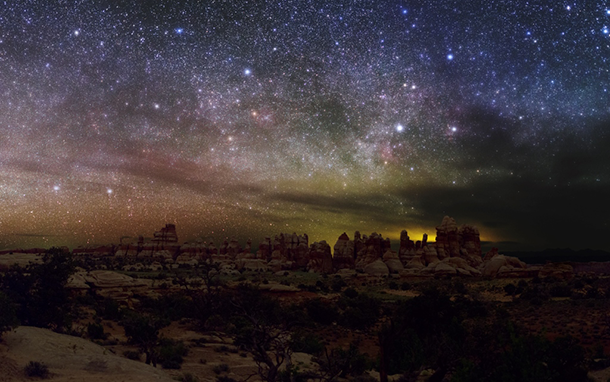
A composite image of the sky above Canyonlands National Park (Photo: Dan Duriscoe, used with permission)
FITZGERALD: It’s hard to complain about this rock though.
AMENT: Yeah I mean that’s the perfect picture frame for the cosmos. You can’t really complain about that.
FITZGERALD: For years the National Park Service has worked to protect some the most beautiful views in the country — Sentinel Dome at Yosemite, the old faithful geyser at Yellowstone, the Grand Canyon. Nate’s job is to protect the increasingly rare view of a clear night sky. It’s part of a recent initiative within the National Park Service.
AMENT: The idea goes back quite a ways to several rangers in the National Park Service who were really enthusiastic about getting people out under the night skies, and they wanted to know where the really dark places and they wanted to know how to preserve those really dark places.
FITZGERALD: And so the Natural Skies and Night Sounds division of the National Park Service was born.
AMENT: And they measure how dark the skies are in parks. I think they’ve taken measurements in over 400 locations. So we have this really rich dataset of darkness all over the entire country.
FITZGERALD: One metric for darkness is called the Bortle Scale, and it rates the sky from 1 to 9.
AMENT: Where we are right now because of the light pollution from Grand Junction and Moab would be like a Bortle Class 3. Whereas if you went into the middle of New York City it’s a Bortle Class 9, the other end of the spectrum, the brightest of the bright, you can’t really see any stars.
FITZGERALD: Humans have lit up so much of the world that it’s almost impossible to find a Bortle Class 1 anymore. But some of the darkest skies in the country are right here at the four corners where Utah, Colorado, Arizona and New Mexico meet on the high desert of the Colorado plateau. Canyonlands National Park, just down the road from Arches has been measured at a Bortle class 2, and was recently named an International Dark Skies Park. It’s the seventh on the Colorado Plateau to get that honor.
AMENT: And that’s by far the highest concentration of these parks in the entire world. There’s only 28 worldwide so we have 7 of them right here on the Colorado plateau.
FITZGERALD: With so much federally protected land on the plateau, Nate says there’s a chance to preserve a really large swath of darkness right in the heart of the West. He works with towns like Moab to cut unnecessary lighting and introduce technologies like light shields that reduce sky glow. Smart lighting isn’t really a hard sell when you explain how much money it can save. One town that’s been particularly forward thinking about its lights is Flagstaff, Arizona.
AMENT: There’s one study that estimates if the entire state of Arizona were to take up Flagstaff’s lighting practices it could save the state $30 million a year. So that gets people attention.
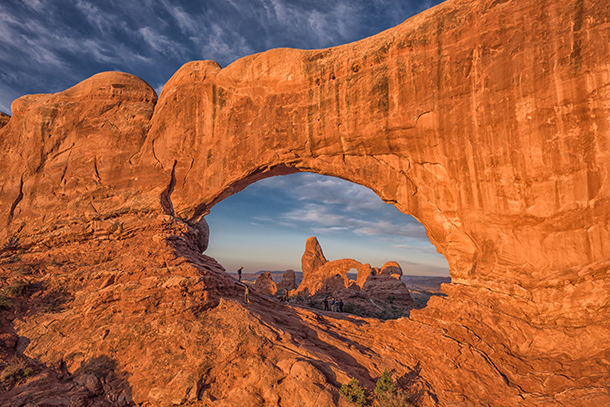
Arches National Park has over 2,000 natural stone arches, hundreds of soaring pinnacles, massive fins and giant balanced rocks. (Photo: Diana Robinson, Flickr CC BY-ND 2.0)
FITZGERALD: Nate says reducing light pollution isn’t just about aesthetics. There’s a growing medical consensus that overexposure to artificial light can disrupt human circadian rhythms, and may even contribute to health problems like diabetes and certain cancers. And the excess light impacts wildlife as well.
AMENT: There’s a lot of documented cases of bird migrations being disrupted by bright white lights. Bats have their predator pray cycles disrupted because insects flock to these bright lights. There’s a lot of interference in other predator prey relationships that can be really disruptive to certain ecosystems.
FITZGERALD: But as well as helping wildlife inside the park, Nate just wants to give the many people who live in over-lit cities a shot at seeing the night sky as Edward Abbey would have seen it.
AMENT: Two-thirds of the people in the world can’t see the Milky Way from where they live. And so you get an idea of how rare it is to come out and see these dark skies in places like Arches and Canyonlands, and you can see why people come from all over the world to see them. And a lot of visitors will say it’s by far the most exciting and memorable part of their trip when they go around the camp and ask what was your favorite experience, what will you remember most, people say seeing the Milky Way overhead overnight when I slept out, or seeing the stars in the dark sky that I’d never seen before.
[FOOTSTEPS]
FITZGERALD: As we head back, we come across two men with binoculars looking up at the sky. Ken and Robert are east coast friends on a road trip through the west.
ROBERT: Well we came out because we’re looking for pitch dark. The moon is kind of spoiling it a little bit although it’s beautiful too, but we wanted to see as many stars as we could. Clear, no moisture, it’s beautiful. We weren’t going to leave here without coming out at night.
FITZGERALD: Ken and Robert aren´t the only ones out here at night. Flashlights held by stargazers flicker on and off throughout the park. Robert says he really appreciates that Arches keeps the gates open after hours. This view is part of why he made this trip in the first place.
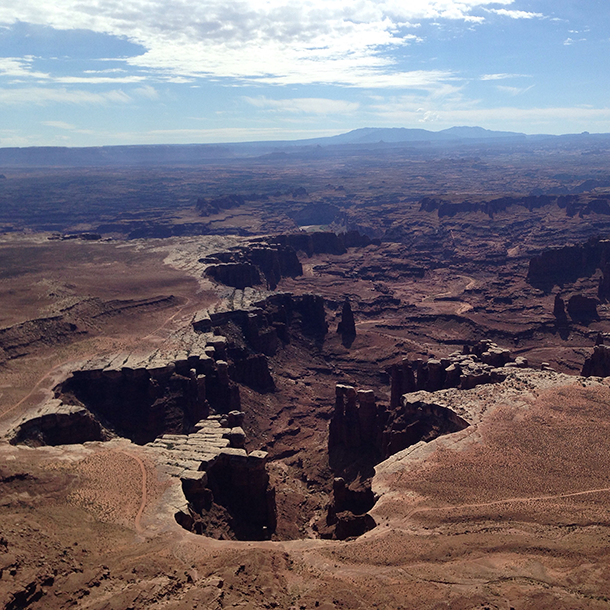
Author Edward Abbey described the Canyonlands as "the most weird, wonderful, magical place on earth—there is nothing else like it anywhere.” (Photo: Emmett FitzGerald)
ROBERT: It’s just cool. When it gets so dark you can see the Milky Way clear, look at how far away you’re looking. You think about little things like how long it took that light to get here. Stuff like that.
FITZGERALD: As we walk back to the car Nate’s smiling.
AMENT: Yeah it’s super gratifying to see somebody and just talk to them and they’re from out of town and “what brings you here?” “Well I came out here for the dark skies and the stars” and it’s like, "Yes! I’m doing my job! Alright."
[FOOTSTEPS]
FITZGERALD: In the 20th century, conservationists like Ed Abbey worked tirelessly to protect the air and water and wildlife in parks like this one. And Nate Ament is adding a resource for the 21st century to that list, a clear night sky like this one, spread out from horizon to horizon.
For Living on Earth this is Emmett FitzGerald at Arches National Park.
Related links:
- Canyonlands named an International Dark Skies Park
- Arches National Park
- Nate Ament is part of the Colorado Plateau Dark Skies Cooperative
- Abbey’s Desert Solitaire
- The Bortle Scale
- Light pollution adversely affects some wildlife
[MUSIC: Brian Eno and Harold Budd, Falling Light, Ambient 2 The Plateaux of Mirrors, Editions EG]
CURWOOD: Living on Earth is produced by the World Media Foundation. Our crew includes Naomi Arenberg, Bobby Bascomb, Emmett Fitzgerald, Lauren Hinkel, Helen Palmer, Adelaide Chen, Jenni Doering, John Duff, Amber Rodriguez, Jaime Kaiser and Jennifer Marquis. Tom Tiger engineered our show, with help from John Jessoe, Jake Rego and Noel Flatt. Alison Lirish Dean composed our themes. You can find us anytime at LOE.org - and like us, please, on our Facebook page - it’s PRI’s Living on Earth. And we tweet from @LivingOnEarth. I'm Steve Curwood. Thanks for listening.
ANNOUNCER1: Funding for Living on Earth comes you, our listeners, and from the University of Massachusetts, Boston, in association with its School for the Environment, developing the next generation of environmental leaders. And from the Grantham Foundation for the protection of the environment, supporting strategic communications and collaboration in solving the world’s most pressing environmental problems. And Gilman Ordway for coverage of conservation and environmental change. Also from SolarCity, America’s solar power provider. SolarCity is dedicated to revolutionizing the way energy is delivered by giving customers a renewable alternative to fossil fuels. Information at 888-997-1703. That’s 888-997-1703.
ANNOUNCER2: PRI. Public Radio International.
Living on Earth wants to hear from you!
Living on Earth
62 Calef Highway, Suite 212
Lee, NH 03861
Telephone: 617-287-4121
E-mail: comments@loe.org
Newsletter [Click here]
Donate to Living on Earth!
Living on Earth is an independent media program and relies entirely on contributions from listeners and institutions supporting public service. Please donate now to preserve an independent environmental voice.
NewsletterLiving on Earth offers a weekly delivery of the show's rundown to your mailbox. Sign up for our newsletter today!
 Sailors For The Sea: Be the change you want to sea.
Sailors For The Sea: Be the change you want to sea.
 The Grantham Foundation for the Protection of the Environment: Committed to protecting and improving the health of the global environment.
The Grantham Foundation for the Protection of the Environment: Committed to protecting and improving the health of the global environment.
 Contribute to Living on Earth and receive, as our gift to you, an archival print of one of Mark Seth Lender's extraordinary wildlife photographs. Follow the link to see Mark's current collection of photographs.
Contribute to Living on Earth and receive, as our gift to you, an archival print of one of Mark Seth Lender's extraordinary wildlife photographs. Follow the link to see Mark's current collection of photographs.
 Buy a signed copy of Mark Seth Lender's book Smeagull the Seagull & support Living on Earth
Buy a signed copy of Mark Seth Lender's book Smeagull the Seagull & support Living on Earth

